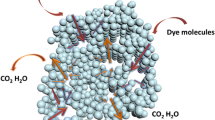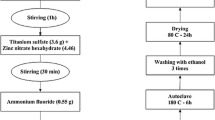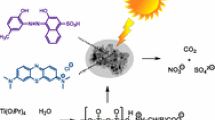Abstract
Mesoporous titanium dioxide (TiO2) photocatalysts were synthesized via a solvothermal method using sodium dodecyl sulfate (SDS) as templates. The effect of the SDS concentration and solution pH value on the resulting TiO2 catalyst and its photocatalytic activity were studied. The photocatalytic activity was assessed by degradation methylene blue under low-power (8W × 4) UV light irradiation. The best performance showed that over 95% of methylene blue was degraded in 120 min and in the presence of S20 (20 mmol SDS addition, pH = 4). With the optimal addition of SDS, the crystal size was reduced, and the surface area was increased. In addition, some bidentate-sulfates (–SO42−) residues were observed within the prepared mesoporous TiO2. The Detail characterization of of the as-prepared TiO2 samples were conducted by X-ray diffraction, Ultraviolet–Visible Spectroscopy, Scanning electron microscope, Brunauer-Emmett-Teller analysis, and Fourier-transform infrared spectroscopy, respectively.







Similar content being viewed by others

References
Trandafilović LV, Jovanović DJ, Zhang X, Ptasińska S, Dramićanin M (2017) Enhanced photocatalytic degradation of methylene blue and methyl orange by ZnO: Eu nanoparticles. Appl Catal B 203:740–752
Hsieh L-HC, Ou H-H, Huang C-W (2019) Adsorption of Cu (II) in aqueous solution using microwave-assisted titanate nanotubes. Appl Nanosci 9(4):505–514
Feng Y, Yang S, Xia L, Wang Z, Suo N, Chen H, Long Y, Zhou B, Yu Y (2019) In-situ ion exchange electrocatalysis biological coupling (i-IEEBC) for simultaneously enhanced degradation of organic pollutants and heavy metals in electroplating wastewater. J Hazard Mater 364:562–570
Rathore BS, Sharma G, Pathania D, Gupta VK (2014) Synthesis, characterization and antibacterial activity of cellulose acetate–tin (IV) phosphate nanocomposite. Carbohydr Polym 103:221–227
Sharma G, Pathania D, Naushad M, Kothiyal N (2014) Fabrication, characterization and antimicrobial activity of polyaniline Th (IV) tungstomolybdophosphate nanocomposite material: efficient removal of toxic metal ions from water. Chem Eng J 251:413–421
Joss A, Zabczynski S, Göbel A, Hoffmann B, Löffler D, McArdell CS, Ternes TA, Thomsen A, Siegrist H (2006) Biological degradation of pharmaceuticals in municipal wastewater treatment: proposing a classification scheme. Water Res 40(8):1686–1696
Yang C-Y, Chiu H-F, Cheng M-F, Tsai S-S (1998) Chlorination of drinking water and cancer mortality in Taiwan. Environ Res 78(1):1–6
Ikehata K, Gamal El-Din M, Snyder SA (2008) Ozonation and advanced oxidation treatment of emerging organic pollutants in water and wastewater. Ozone: Sci Eng 30 (1):21–26
Sharma G, Kumar A, Sharma S, Ala'a H, Naushad M, Ghfar AA, Ahamad T, Stadler FJ (2019) Fabrication and characterization of novel Fe0@ Guar gum-crosslinked-soya lecithin nanocomposite hydrogel for photocatalytic degradation of methyl violet dye. Sep Purif Technol 211:895–908
Raizada P, Sudhaik A, Singh P, Hosseini-Bandegharaei A, Thakur P (2019) Converting type II AgBr/VO into ternary Z scheme photocatalyst via coupling with phosphorus doped g-C3N4 for enhanced photocatalytic activity. Sep Purif Technol 227:115692
Raizada P, Sudhaik A, Singh P, Shandilya P, Thakur P, Jung H (2020) Visible light assisted photodegradation of 2, 4-dinitrophenol using Ag2CO3 loaded phosphorus and sulphur co-doped graphitic carbon nitride nanosheets in simulated wastewater. Arab J Chem 13(1):3196–3209
Kumar A, Raizada P, Singh P, Saini R, Saini A, Hosseini-Bandegharaei A (2019) Perspective and status of polymeric graphitic carbon nitride based Z-scheme photocatalytic systems for sustainable photocatalytic water purification. Chem Eng J. https://doi.org/10.1016/j.cej.2019.123496
Huang C-W, Nguyen B-S, Wu JC-S, Nguyen V-H (2019) A current perspective for photocatalysis towards the hydrogen production from biomass-derived organic substances and water. Int J Hydrog Energy. https://doi.org/10.1016/j.ijhydene.2019.08.121
Elango G, Roopan SM (2016) Efficacy of SnO2 nanoparticles toward photocatalytic degradation of methylene blue dye. J Photochem Photobiol B 155:34–38
Qin J, Zhang X, Yang C, Cao M, Ma M, Liu R (2017) ZnO microspheres-reduced graphene oxide nanocomposite for photocatalytic degradation of methylene blue dye. Appl Surf Sci 392:196–203
Regmi C, Kshetri YK, Ray SK, Pandey RP, Lee SW (2017) Utilization of visible to NIR light energy by Yb+3, Er+3 and Tm+3 doped BiVO4 for the photocatalytic degradation of methylene blue. Appl Surf Sci 392:61–70
Ismail AA, Faisal M, Al-Haddad A (2018) Mesoporous WO3-graphene photocatalyst for photocatalytic degradation of Methylene Blue dye under visible light illumination. J Environ Sci 66:328–337
Sudhaik A, Raizada P, Shandilya P, Jeong D-Y, Lim J-H, Singh P (2018) Review on fabrication of graphitic carbon nitride based efficient nanocomposites for photodegradation of aqueous phase organic pollutants. J Ind Eng Chem 67:28–51
Singh P, Shandilya P, Raizada P, Sudhaik A, Rahmani-Sani A, Hosseini-Bandegharaei A (2018) Review on various strategies for enhancing photocatalytic activity of graphene based nanocomposites for water purification. Arab J Chem 13:3498–3520
Atout H, Álvarez MG, Chebli D, Bouguettoucha A, Tichit D, Llorca J, Medina F (2017) Enhanced photocatalytic degradation of methylene blue: preparation of TiO2/reduced graphene oxide nanocomposites by direct sol–gel and hydrothermal methods. Mater Res Bull 95:578–587
Ni M, Leung MKH, Leung DYC, Sumathy K (2007) A review and recent developments in photocatalytic water-splitting using TiO2 for hydrogen production. Renew Sustain Energy Rev 11(3):401–425. https://doi.org/10.1016/j.rser.2005.01.009
Leung DYC, Fu X, Wang C, Ni M, Leung MKH, Wang X, Fu X (2010) Hydrogen production over titania-based photocatalysts. ChemSusChem 3(6):681–694. https://doi.org/10.1002/cssc.201000014
Huang C-W, Liao C-H, Wu JC, Liu Y-C, Chang C-L, Wu C-H, Anpo M, Matsuoka M, Takeuchi M (2010) Hydrogen generation from photocatalytic water splitting over TiO2 thin film prepared by electron beam-induced deposition. Int J Hydrog Energy 35(21):12005–12010
Szczepanik B (2017) Photocatalytic degradation of organic contaminants over clay-TiO2 nanocomposites: a review. Appl Clay Sci 141:227–239
Lakshmana Reddy N, Cheralathan KK, Durga Kumari V, Neppolian B, Muthukonda Venkatakrishnan S (2018) Photocatalytic reforming of biomass derived crude glycerol in water: a sustainable approach for improved hydrogen generation using Ni(OH)2 Decorated TiO2 nanotubes under solar light irradiation. ACS Sustain Chem Eng 6(3):3754–3764. https://doi.org/10.1021/acssuschemeng.7b04118
Praveen Kumar D, Lakshmana Reddy N, Mamatha Kumari M, Srinivas B, Durga Kumari V, Sreedhar B, Roddatis V, Bondarchuk O, Karthik M, Neppolian B, Shankar MV (2015) Cu2O-sensitized TiO2 nanorods with nanocavities for highly efficient photocatalytic hydrogen production under solar irradiation. Sol Energy Mater Sol Cells 136:157–166. https://doi.org/10.1016/j.solmat.2015.01.009
Xu F, Zhang L, Cheng B, Yu J (2018) Direct Z-scheme TiO2/NiS core–shell hybrid nanofibers with enhanced photocatalytic H2-production activity. ACS Sustain Chem Eng 6(9):12291–12298. https://doi.org/10.1021/acssuschemeng.8b02710
Xin Y, Lu Y, Han C, Ge L, Qiu P, Li Y, Fang S (2017) Novel NiS cocatalyst decorating ultrathin 2D TiO2 nanosheets with enhanced photocatalytic hydrogen evolution activity. Mater Res Bull 87:123–129. https://doi.org/10.1016/j.materresbull.2016.11.027
Puskelova J, Baia L, Vulpoi A, Baia M, Antoniadou M, Dracopoulos V, Stathatos E, Gabor K, Pap Z, Danciu V, Lianos P (2014) Photocatalytic hydrogen production using TiO2–Pt aerogels. Chem Eng J 242:96–101. https://doi.org/10.1016/j.cej.2013.12.018
Aghasiloo P, Yousefzadeh M, Latifi M, Jose R (2019) Highly porous TiO2 nanofibers by humid-electrospinning with enhanced photocatalytic properties. J Alloy Compd 790:257–265. https://doi.org/10.1016/j.jallcom.2019.03.175
Wang J, Li X, Li X, Zhu J, Li H (2013) Mesoporous yolk–shell SnS 2–TiO2 visible photocatalysts with enhanced activity and durability in Cr (vi) reduction. Nanoscale 5(5):1876–1881
Kachbouri S, Elaloui E, Moussaoui Y (2019) The effect of surfactant chain length and type on the photocatalytic activity of mesoporous TiO2 nanoparticles obtained via modified sol-gel process. Iran J Chem Chem Eng IJCCE) 38(1):17–26
Mamaghani AH, Haghighat F, Lee C-S (2019) Systematic variation of preparation time, temperature, and pressure in hydrothermal synthesis of macro-/mesoporous TiO2 for photocatalytic air treatment. J Photochem Photobiol A 378:156–170
Mamaghani AH, Haghighat F, Lee C-S (2019) Hydrothermal/solvothermal synthesis and treatment of TiO2 for photocatalytic degradation of air pollutants: preparation, characterization, properties, and performance. Chemosphere 219:804–825
Mitra A, Bhaumik A, Paul BK (2008) Synthesis and characterization of mesoporous titanium dioxide using self-assembly of sodium dodecyl sulfate and benzyl alcohol systems as templates. Microporous Mesoporous Mater 109(1–3):66–72
Chowdhury IH, Ghosh S, Naskar MK (2016) Aqueous-based synthesis of mesoporous TiO2 and Ag–TiO2 nanopowders for efficient photodegradation of methylene blue. Ceram Int 42(2):2488–2496
Zhao T, Luo W, Deng Y, Luo Y, Xu P, Liu Y, Wang L, Ren Y, Jiang W (2016) Monodisperse mesoporous TiO2 microspheres for dye sensitized solar cells. Nano Energy 26:16–25
Wang T, Li W, Xu D, Wu X, Cao L, Meng J (2017) A novel and facile synthesis of black TiO2 with improved visible-light photocatalytic H2 generation: impact of surface modification with CTAB on morphology, structure and property. Appl Surf Sci 426:325–332
Linacero R, Aguado-Serrano J, Rojas-Cervantes M (2006) Preparation of mesoporous TiO2 by the sol–gel method assisted by surfactants. J Mater Sci 41(8):2457–2464
Chen Y, Stathatos E, Dionysiou DD (2008) Microstructure characterization and photocatalytic activity of mesoporous TiO2 films with ultrafine anatase nanocrystallites. Surf Coat Technol 202(10):1944–1950
Bamne J, Taiwade K, Sharma P, Haque FZ (2018) Effect of calcination temperature on the growth of TiO2 nanoparticle prepared via sol–gel method using triton X-100 as surfactant. In: AIP Conference Proceedings vol 1. AIP Publishing LLC, College Park
Liu Y, Lan K, Bagabas AA, Zhang P, Gao W, Wang J, Sun Z, Fan J, Elzatahry AA, Zhao D (2016) Ordered macro/mesoporous TiO2 hollow microspheres with highly crystalline thin shells for high-efficiency photoconversion. Small 12(7):860–867
Estrada-Flores S, Martínez-Luévanos A, Perez-Berumen CM, García-Cerda LA, Flores-Guia TE (2019) Relationship between morphology, porosity, and the photocatalytic activity of TiO2 obtained by sol–gel method assisted with ionic and nonionic surfactants. Boletín de la Sociedad Española de Cerámica y Vidrio. https://doi.org/10.1016/j.bsecv.2019.10.003
Selvaraj P, Roy A, Ullah H, Sujatha Devi P, Tahir AA, Mallick TK, Sundaram S (2019) Soft-template synthesis of high surface area mesoporous titanium dioxide for dye‐sensitized solar cells. Int J Energy Res 43(1):523–534
Sun B, Zhou G, Shao C, Jiang B, Pang J, Zhang Y (2014) Spherical mesoporous TiO2 fabricated by sodium dodecyl sulfate-assisted hydrothermal treatment and its photocatalytic decomposition of papermaking wastewater. Powder Technol 256:118–125
Fernández IE, Rodríguez-Páez J (2019) Wet-chemical preparation of TiO2-nanostructures using different solvents: effect of CTAB concentration and tentative mechanism of particle formation. J Alloy Compd 780:756–771
Zhang Z, Zhong X, Liu S, Li D, Han M (2005) Aminolysis route to monodisperse titania nanorods with tunable aspect ratio. Angew Chem Int Ed 44(22):3466–3470
Huang CW, Wu MC (2020) Photocatalytic degradation of methylene Blue by UV-assistant TiO2 and natural sericite composites. J Chem Technol Biotechnol. https://doi.org/10.1002/jctb.6392
Monshi A, Foroughi MR, Monshi MR (2012) Modified Scherrer equation to estimate more accurately nano-crystallite size using XRD. World J Nano Sci Eng 2(3):154–160
Kudo A, Miseki Y (2009) Heterogeneous photocatalyst materials for water splitting. Chem Soc Rev 38(1):253–278
Sharma G, Dionysiou DD, Sharma S, Kumar A, Ala’a H, Naushad M, Stadler FJ (2019) Highly efficient Sr/Ce/activated carbon bimetallic nanocomposite for photoinduced degradation of rhodamine B. Catal Today 335:437–451
Kumar A, Sharma SK, Sharma G, Ala’a H, Naushad M, Ghfar AA, Stadler FJ (2019) Wide spectral degradation of Norfloxacin by Ag@ BiPO4/BiOBr/BiFeO3 nano-assembly: Elucidating the photocatalytic mechanism under different light sources. J Hazard Mater 364:429–440
Murphy AB (2007) Band-gap determination from diffuse reflectance measurements of semiconductor films, and application to photoelectrochemical water-splitting. Sol Energy Mater Sol Cells 91 (14):1326–1337
Wang X, Jimmy CY, Liu P, Wang X, Su W, Fu X (2006) Probing of photocatalytic surface sites on SO42–/TiO2 solid acids by in situ FT-IR spectroscopy and pyridine adsorption. J Photochem Photobiol A 179(3):339–347
Wei F, Ni L, Cui P (2008) Preparation and characterization of N–S-codoped TiO2 photocatalyst and its photocatalytic activity. J Hazard Mater 156(1–3):135–140
Shiyanovskaya I, Hepel M (1998) Decrease of recombination losses in bicomponent WO3/TiO2 films photosensitized with cresyl violet and thionine. J Electrochem Soc 145(11):3981–3985
Nakade S, Saito Y, Kubo W, Kitamura T, Wada Y, Yanagida S (2003) Influence of TiO2 nanoparticle size on electron diffusion and recombination in dye-sensitized TiO2 solar cells. J Phys Chem B 107(33):8607–8611
Dai K, Dawson G, Yang S, Chen Z, Lu L (2012) Large scale preparing carbon nanotube/zinc oxide hybrid and its application for highly reusable photocatalyst. Chem Eng J 191:571–578
Tian G, Fu H, Jing L, Xin B, Pan K (2008) Preparation and characterization of stable biphase TiO2 photocatalyst with high crystallinity, large surface area, and enhanced photoactivity. J Phys Chem C 112(8):3083–3089
Acknowledgements
The authors would like to appreciate the Ministry of Science and Technology (MOST) in Taiwan sincerely for providing the funding under MOST (Grant Nos. 106-2218-E-992-304-MY2 and 108-3116-F-006 -013).
Author information
Authors and Affiliations
Corresponding authors
Additional information
Publisher's Note
Springer Nature remains neutral with regard to jurisdictional claims in published maps and institutional affiliations.
Rights and permissions
About this article
Cite this article
Huang, CW., Sin, WC., Nguyen, VH. et al. Solvothermal Synthesis of Mesoporous TiO2 Using Sodium Dodecyl Sulfate for Photocatalytic Degradation of Methylene Blue. Top Catal 63, 1121–1130 (2020). https://doi.org/10.1007/s11244-020-01322-y
Published:
Issue Date:
DOI: https://doi.org/10.1007/s11244-020-01322-y



